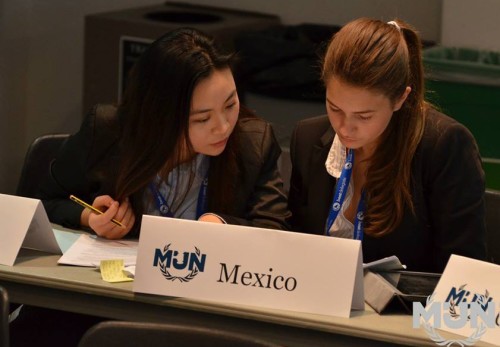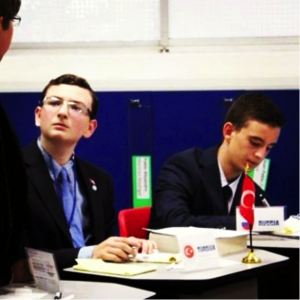This is a guest article submitted by Mauricio Garcia, currently part of our MUN Institute alumni. Mauricio attended last summer to our crisis and secretary general MUNi programs.
*This is a standard of the procedure used in most Mexican conference, especially in the North. The procedure may vary depending the conference and the regions.
Planning on traveling to a conference abroad? Still have doubts on the procedure? Don’t worry! We have designed a whole series on MUN procedures around the world.
For our Second article, we have looked upon the procedure of a country that acts as a major player in the Model UN Latin American circuit: Mexico!
- How does the committee begin?
Before anything, take into account that following the dress code is imminent in Mexico. You can’t take your coat off without first asking permission to do so. Also, take into account that the Mexican procedure is very simplified and some things might not be 100% coherent with the THIMUN and UNAUSA procedures. In Mexico, the dais positions are director and moderator.
First you wait until the moderator says “the floor is now open” and then you have to open the session. For this you lift you placard, and if you were chosen by the moderator you: “motion to open the session,” then the moderator asks for someone to second the motion.
Then the director takes role call attendance (in alphabetical order). You will be the able to say:
- Present (you are able abstain during resolution voting process)
- Present and voting (you are not able to abstain during the resolution voting process).
Most of the time you are asked to say specifically “Present and Voting.” Remember every time the session is going to be open, the director will proceed with the role call. This means you will be able to change your vote.
Remember you are always required to stand up and talk in third person when presenting a motion or a speech. Mexican directors deduct points every time you use personal pronouns or you don’t act diplomatically.
- Position Paper
While most countries call this the “opening speech,” in Mexico, you need to prepare a position paper. This document is in fact, the same opening speech that you give. Once the session is opened, the moderator will call for a motion to open the speakers’ list.
When the speakers’ list is open, the moderator will ask all of those who want to be added to raise their placards and they will be typed into a list. Then the moderator calls for a motion to “set the agenda.” Then the delegate chosen will say how much time a delegate will speak and how many questions and comments will be made. (Although comments are becoming rare.) This motion passes with a simple majority.
Position Papers are read in the order that the director wrote it into the list. When the delegate is called to read his position paper he will have to stand in the front of the room to read it.
If a delegate runs out of time two things can happen:
- Someone motions to let the delegate finish his position paper.
- You can make points of information to ask a question or points of commentary to make a comment.
Rarely conferences will ask delegates if they want to yield their time if they have spare time, normally it automatically passes into questions and comments.
In most conferences, you’ll be required to give a copy of your position paper to the director. It’s better to have spare copies than less when it comes to conferences in Mexico.
2.1 Formal aspects
- The position papers are normally 3 paragraph long, in the first one you state why the issue is important, on the second one you state what is your country’s position and on the third one you state your country’s solutions.
- Remember to include at the top of the position your delegation, the committee you are in, your school, your name and the topics that will be treated in the committee.
- Opening speeches usually start with “Good afternoon fellow delegates…”
- Your position paper is your initial speech, it will define the opinion that other delegates have about you and the directors grade it heavily.
- Moderated Debate
After most of the delegates have passed, the moderator will suggest a Moderated Debate. This is just like a Moderated Caucus, but you don’t need to specify anything else but the time.
If the motion passes, the moderator will call on countries lifting their placards to speak. If chosen you need to stand up in your place and speak. Again, no personal pronouns are allowed at all. Normally, if the delegates take too long in their speeches, moderators will ask them to be brief or they will cut them off the floor.
If you are presenting the motion, remember you should not establish the sub-topic to be discussed. Only set up the time for the debate as a whole (time for the debate usually varies between 20 minutes and an hour depending on the session.) Usually delegates say “As much as the chair recommends.” The time every delegate has to speak is decided by the chair.
For example:
-Delegate: Motion for a Moderated Debate. –Moderator: For how much time delegate? –Delegate: as much as the chair recommends –Director: 20 minutes will be in order, is that okay delegate? –Delegate: yes. –Moderator: The delegate has made a motion for a moderated debate for 20 minutes, all those in favor?
After this, the moderator will call on countries. Moderated debates can be extended with a motion to extend the Moderated Debate.
Remember that, during this time, you are must ask for permission by a note or with a point of personal privilege to exit the room. You may not stand up unless you have the flood.
Unmoderated Debate and resolutions.
When delegates feel ready, they can motion for an Unmoderated Debate. This is a special time for delegates to draft the resolution paper.
Just like the moderated debate, you must ask for permission to exit the room. You must speak the language of the committee all the time. You can’t divide into groups unless you make a motion to split the house.
During this time, you’ll be able to start drafting your resolution and building your bloc.
Resolutions should always include:
- A formal heading:
- Committee
- Topic
- Sponsors (The countries that will pass to read it, usually 2)
- Signatories (The countries that want the resolution to be debated)
- In most conferences, a minimum of 5 pre-ambulatory clauses and 5 operative clauses.
Be careful with the last point, if your draft resolution has less than the minimum required of either one of both, your draft resolution will be automatically tabled down.
Most of the time there are no amendments.
Once all resolutions have arrived to the chair, the moderator will suggest a motion to submit the resolutions. Then sponsors will have to pass to the front and read their respective resolution. Once again, the moderator will suggest a motion to establish the agenda. Again time for the speakers is set along with the amount of questions and comments.
At the end of the lecture, the moderator will take points of information and points of commentary.
- Voting process
In most conferences, there are no amendments to resolutions. Delegates are encouraged to suggest changes during the unmoderated debate.
Once one draft resolution has been read, and amendments are done, the moderator will ask for a motion to enter into voting procedure. During this time no one can enter or exit the room. If a motion for roll call voting is made, delegates will vote in alphabetical order. If not, they will vote by raising their placards when the moderator calls for those in favor, against or abstained. Delegations are able to vote:
- In favor of the resolution
- Against the resolution
- Abstains (If and only if the delegate voted present during the role call)
In most conferences, resolutions pass with a simple majority of the votes in favor. Also, most of them allow the committee to pass one resolution.
After you vote for all the resolutions, the one with the most in-favor votes will pass.
After all resolutions have been read and voted, the passing resolution will go to a second stage. The sponsors will be taken to the General Assembly, where they will repeat the process of reading and voting. If the resolution doesn’t pass in GA, it must be revised by the committee through another unmoderated debate. If it passes, the committee will be announced and it will be able to pass into another topic or to finish the session.
5.Points, motions and other formal aspects.
5.1 Points
- Point of order: It is used every time a delegate considers there was a mistake in the procedure. In most conference it can interrupt another delegate’s intervention.
- Point of personal privilege: It is to inform any unconformity or impediment that doesn’t allows the delegate to develop comfortably in the committee. For example when he/she can’t listen properly to another delegate. It can interrupt another delegate’s intervention. In Mexico, delegates aren’t allowed to take of their coats/jackets unless a motion to do so is passed first. This is decided by the chair, but they normally go over a vote to decide.
- Point of inquiry: It is used when a delegate has an inquiry to the dais on the committee procedure or a word. For example a delegate can establish a point of inquiry when he or she wants to say a word that he/she only know in his/her native language.
5.3 Other formal aspects:
Almost all conferences have warnings for not following the procedure.
3 verbal warnings equal a written warning. 3 written warnings means that you are taken out of the session.
Also, in almost all MUN conferences you’ll be able to use the right to reply when your delegation feels directly offended by other delegate. However, the formal procedure on the right of reply does vary a lot from one conference to another.
Finally, remember that Mexican conferences are always subject to changes, don’t be afraid to ask questions if something isn’t clear.
***
Do you have any questions? Want to know more about Mexican procedure? Want to know about Mexican Conferences? Feel free to comment bellow or email us.




